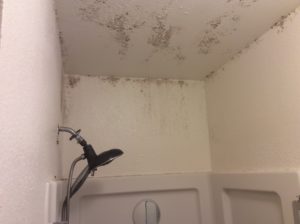This species of mold appears black or dark green and has a unique shine to the surface. Some would describe it as slimy-looking, but if it dries it often becomes gray and powder-like. The problem is when it comes to black mold identification, the only real way to confirm if it’s a dangerous, toxic species is with a microscope. Many different molds have similar appearance to Stachybotrys atra. Only with proper testing by an expert, can the species be accurately identified.
Low levels of Stachybotrys atra tend not to have any effect on most adults, though if you’re immuno-compromised it’s more likely to cause symptoms. Larger volumes of mold and greater exposure can cause a variety of symptoms sometimes referred to as Toxic Mold Syndrome. Below are some common symptoms.
- Chronic coughing or sneezing
- Throat irritation
- Rashes
- Sinusitis
- Asthmatic Attacks
- Conjunctivitis
- Chronic Fatigue
- Persistent Headaches
These symptoms usually diminish or clear completely soon after removing the mold and its source.
Black mold affects animals too. While you may not notice a small spot of mold growing in that dark corner of your basement, you can be sure your pet will! Their curious nature may lead them to direct contact with the mold, causing illness or other reactions. If you have pets, keep an eye out for symptoms and take them to the vet immediately! Then contact a professional to inspect and locate the source of your mold and cause of growth.
Signs of dangerous molds in homes.
There are a few clear signs of house mold that help you identify if your home needs mold remediation:
-Musty Oder
Mold gives off a clear smell of mildew. Unfortunately, some have come to associate this smell with basements and often don’t realize that a musty smell isn’t normal in a healthy environment. Because mold can hide out of plain sight, or often behind walls, it’s not uncommon to get used to the smell instead of realizing something is wrong.
-Visible Mold Growth
Obviously, if you see visible mold, you’ll know it’s there. That said, because of the conditions required to thrive, mold often grows in less conspicuous places. After all, if growth were in plain sight, you would likely fix the crack or remove the moisture quickly. Chances are if you can see mold, there’s more hidden nearby. While that’s not always the case, it’s important to realize that your health is at risk if you inhale mold spores.
-Experiencing Respiratory Symptoms.
The symptoms mentioned earlier related to black mold sometimes apply to other molds as well. Most often, molds will cause respiratory effects such as worsening asthma symptoms or causing allergic reactions. If you suddenly begin to exhibit symptoms like these, with no history of allergies or other problems, consider looking for potential environments mold could grow to help determine if there’s a connection to your respiratory symptoms.
Any Mold can be Dangerous
The pigmentation in molds and their toxicity are not in any way connected. There are a number of molds that happen to be black or dark green in color, resembling Stachybotrys, but do not contain any of the toxins that make “black mold” so dangerous.
It is fundamentally impossible to look at a mold spore and determine if it’s dangerous or not. That’s why it’s important to contact a professional if you think you’ve discovered mold. This holds true in the reverse scenario as well – just because mold growth isn’t black, that doesn’t indicate it is safe or non-toxic. Ultimately, while some molds may not be toxic or poisonous, they still indicate a problem and should be properly handled by an expert.
Don’t attempt to remove them unless you’re 100% sure they’re safe and you’re wearing protective equipment. It’s always better to contact a professional who can attack mold at its source by repairing cracked foundations or other sources of moisture and properly dry the source out.
The Importance of Removing Mold’s Moisture Source
One of the most common mistakes when dealing with mold is cleaning up the visible mold and calling it a day. Think of it as weeds; you need to remove the root for it to stop growing. Until you fix the source of moisture that is feeding the mold, it will continue to come back no matter what. Every time you clean up small spots of mold without correcting the issue, you expose yourself to more spores and possible toxins as well as run the risk of transporting the spores to other areas of your home or business.
It is possible to perform some basic DIY waterproofing, but for the bigger issues, it’s best to leave it to the professionals.
So, when addressing mold in your home, remember to call the professionals at West Coast Fire & Water.



 House molds are a growing concern in the minds of homeowners across the nation. Regardless of your area’s climate, leaks and cracks can promote mold growth in any nook or cranny of your home. Often, these growths go unnoticed for days, weeks, or even months, allowing them to become health hazards and even damage your property. Certain molds are more dangerous than others; black mold identification, in particular, has become an important topic for property owners.
House molds are a growing concern in the minds of homeowners across the nation. Regardless of your area’s climate, leaks and cracks can promote mold growth in any nook or cranny of your home. Often, these growths go unnoticed for days, weeks, or even months, allowing them to become health hazards and even damage your property. Certain molds are more dangerous than others; black mold identification, in particular, has become an important topic for property owners.